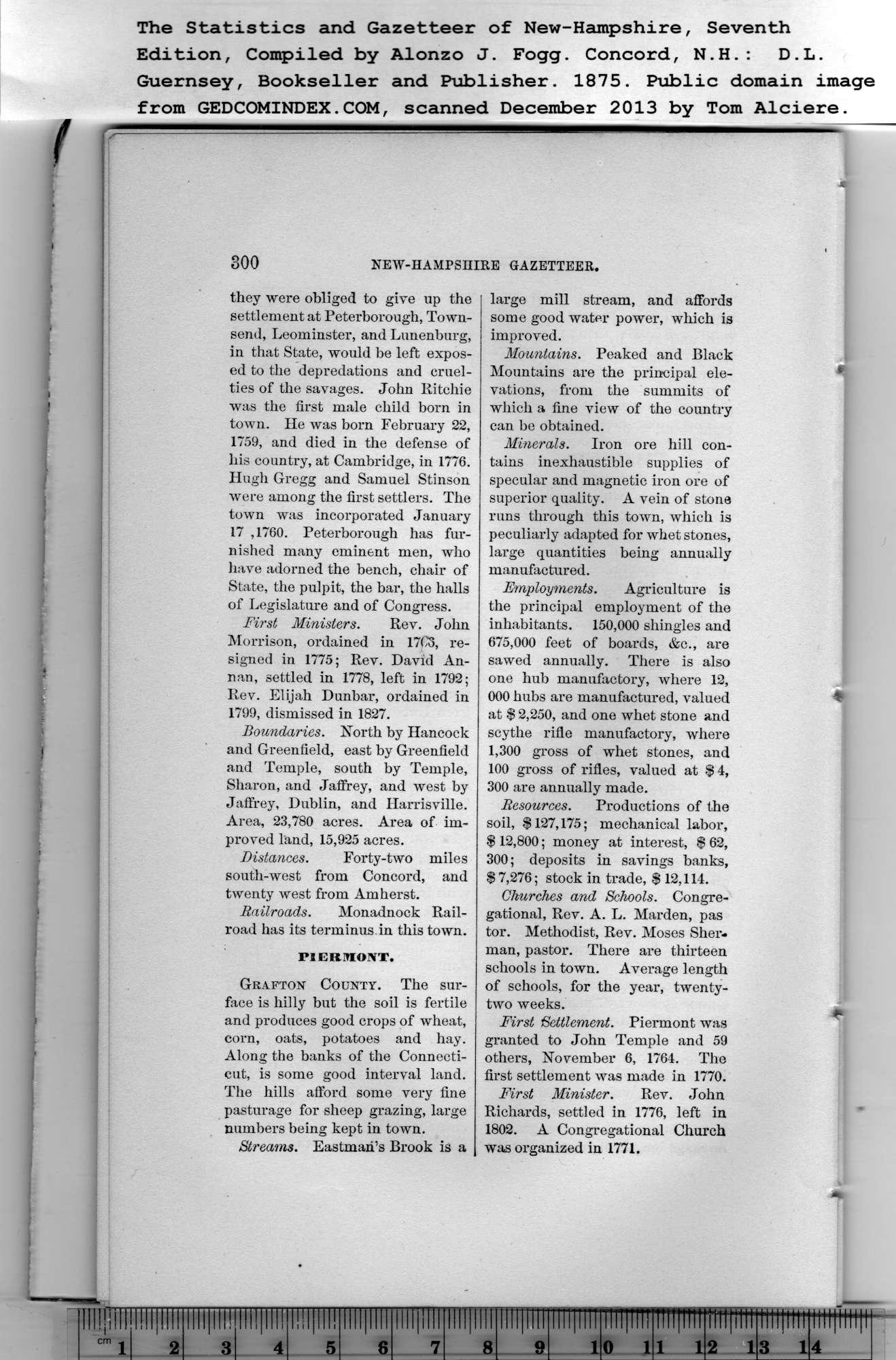|
they were obliged to give up the
settlement at Peterborough, Town-
send, Leominster, and Lunenburg,
in that State, would be left expos-
ed to the depredations and cruel-
ties of the savages. John Ritchie
was the first male child born in
town. He was bom February 22,
1759, and died in the defense of
his country, at Cambridge, in 1776.
Hugh Gregg and Samuel Stinson
were among the first settlers. The
town was incorporated January
17 ,1760. Peterborough has fur-
nished many eminent men, who
have adorned the bench, chair of
State, the pulpit, the bar, the halls
of Legislature and of Congress.
First Ministers. Rev. John
Morrison, ordained in 17(73, re-
signed in 1775; Rev. David An-
nan, settled in 1778, left in 1792;
Rev. Elijah Dunbar, ordained in
1799, dismissed in 1827.
Boundaries. North by Hancock
and Greenfield, east by Greenfield
and Temple, south by Temple,
Sharon, and Jaffrey, and west by
Jaffrey, Dublin, and Harrisville.
Area, 23,780 acres. Area of im-
proved land, 15,925 acres.
Distances. Forty-two miles
south-west from Concord, and
twenty west from Amherst.
Railroads. Monadnock Rail-
road has its terminus in this town.
PIGRMONT.
Grafton County. The sur-
face is hilly but the soil is fertile
and produces good crops of wheat,
corn, oats, potatoes and hay.
Along the banks of the Connecti-
cut, is some good interval land.
The hills afford some very fine
pasturage for sheep grazing, large
numbers being kept in town. |
Streams. Eastman’s Brook is a
large mill stream, and affords
some good water power, which is
improved.
Mountains. Peaked and Black
Mountains are the principal ele-
vations, from the summits of
which a fine view of the country
can be obtained.
Minerals. Iron ore hill con-
tains inexhaustible supplies of
specular and magnetic iron ore of
superior quality. A vein of stone
runs through this town, which is
peculiarly adapted for whet stones,
large quantities being annually
manufactured.
Employments. Agriculture is
the principal employment of the
inhabitants. 150,000 shingles and
675,000 feet of boards, &c., are
sawed annually. There is also
one hub manufactory, where 12,
000 hubs are manufactured, valued
at $ 2,250, and one whet stone and
scythe rifle manufactory, where
1,300 gross of whet stones, and
100 gross of rifles, valued at $4,
300 are annually made.
Resources. Productions of the
soil, $127,175; mechanical labor,
$ 12,800; money at interest, $ 62,
300; deposits in savings banks,
$7,276; stock in trade, $ 12,114.
Churches and Schools. Congre-
gational, Rev. A. L. Marden, pas
tor. Methodist, Rev. Moses Sher-
man, pastor. There are thirteen
schools in town. Average length
of schools, for the year, twenty-
two weeks.
First Settlement. Piermont was
granted to John Temple and 59
others, November 6, 1764. The
first settlement was made in 1770.
First Minister. Rev. John
Richards, settled in 1776, left in
1802. A Congregational Church
was organized in 1771. |
